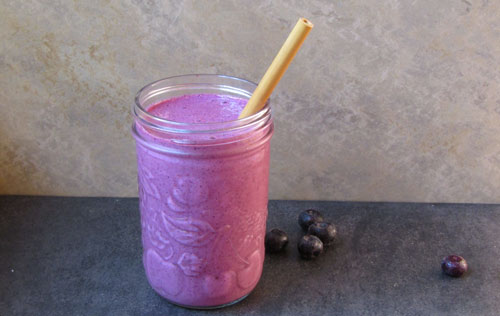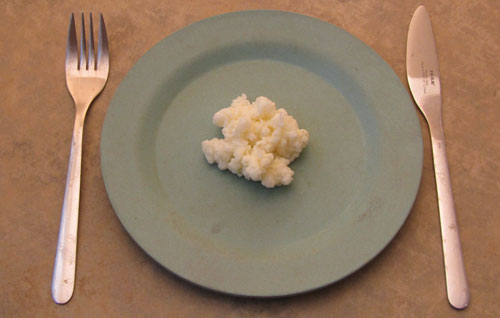This post contains affiliate links.
Once you start making kefir you will soon begin to experience a problem most kefir makers come across. Your kefir grains continue to grow and soon begin to overrun your containers. Since you don’t want to just throw them out can they be eaten?
Kefir grains can be eaten since their makeup has four main components: proteins, lipids, polysaccharide and a symbiotic culture of bacteria and yeasts. Kefir grains provide a highly absorbable form of protein, insoluble fiber and live probiotic cultures high in B vitamins and calcium.
Proteins
There are up to 1500 different peptides found in kefir, 609 of these peptides are unique. Peptides are used by your body to build muscle and bone, are used in the production of collagen which helps maintain healthy skin as well as cell replication.
Lipids
Lipids in kefir grains come from the fat component of the milk the grains are fermenting. Lipids are important fatty acids. They are used in signaling, energy storage and vitamin transport to the cells in the body.
Polysaccharides
The polysaccharides which are found in milk is mostly made up of lactose, which is hard for some to digest but the cultures in the grains use this sugar for food and therefor break it down into simpler, more easily digested sugars. Some of this sugar is included in the grains to help maintain the cultures which call the grains home. As the various micro-organisms consume these sugars the saccharide chains get smaller and smaller.
The smallest form of sugar in a mono-saccharide, meaning one sugar molecule. This is the most easily digested form of sugar and is what your cells use for energy. The closer to a mono-saccharide the sugar is the more readily available it is for your body.
Bacteria and yeast
The bacteria and yeasts found in kefir are not pathogenic in nature. They have the ability to survive through the stomach and help the gut to remain slightly acidic. This helps keep your gut healthy and strong.
How kefir grains taste
Kefir grains taste like slightly sour kefir. The lactic acid the grains produce is concentrated around the grains making them tangier then the kefir milk they produce. They have a firm texture not unlike a gummy bear.
How to eat kefir grains
Kefir grains are white cauliflower shaped formations which seem to grow with time. When they are first filtered out of the milk they don’t seem very appetizing but with a little imagination they can be consumed in a variety of ways.
Blended into smoothies

This is my favorite method of using extra kefir grains. The grains are added into the smoothie along with all the other ingredients and if you are using a high powered blender you will not even notice they are there.
The benefit of this method is the grains get reduced to tiny particles which adds a degree of creaminess to the smoothie and makes it a little thicker. They do not change the flavor besides making it a little tangier.
Added to salads dressing
Another blender option is making salad dressing. Just put all the ingredients into the blender and blend until smooth.
Kefir grains make a great addition to salad dressing as they make the dressing thicker and give it a creamy texture. The fats in the kefir grains mix well with the oil used for the salad dressing and the vinegar reduces the stringy texture.
The salad dressing is best made shortly before you use it. This is because the cultures in the grains will remain active and will continue to acidify the dressing. The yeasts in the grains will begin immediately to break down the sugar in the dressing making it less sweet, the lactic acid bacteria begin to produce lactic acid making the dressing sour.
Baked into casseroles
The kefir grains will soften and add to the creamy texture of the casserole. Adding kefir grains to a creamy mushroom casserole or a mac and cheese add protein which is easily digestible.
If the casserole has some type of pasta then the kefir grains will not be distinguishable but will add valuable fats and proteins which can be easily used by your body.
Added to a stir Fry
A stir fry is a perfect way to use some of those extra kefir grains. Drain them and pat them dry. Then slice them thin and add them with the mushrooms and onions just before the tender vegetables get added.
The kefir grains will add a new texture as well as a slightly sour tang to the dish.
Added into soups
Depending on how long you simmer your soup will produce different textures of grains in the soup. If the kefir grains are added close to the end of the cook time the grains will retain their original texture.
When they are added at the beginning the grains will soften and may dissipate into the soup. Which is okay as the proteins fats and lipids will still remain in the soup making it more nutritious without change in the texture of the soup.
Another option is blended soups like cream of mushroom, carrot or onion soup. These can all be made in the blender easily with the addition of kefir grains.
Used as a thickener for gravies and salad dressings
Gravies are usually thickened using some form of gluten but they can also be thickened with concentrated proteins which is what kefir grains contain.
The process is a bit different then using gluten as the gravy doesn’t thicken by forming gluten strings but through making it less hydrogenated (less water per cup).
Make kefir grain gravy by cooling the drippings slightly, ladle off the fat which rises to the top. Pour the drippings into a blender along with some kefir grains and a few of the vegetables which were cooked in the roaster. Blend until smooth. Adjust for thickness by adding more grains or more drippings as needed.
Season to taste and serve immediately.
Use them as a starter for sourdough
Kefir grains have similar characteristics to sourdough starter in that they are collections of bacteria and yeast cultures. The yeasts convert the carbohydrates it comes into contact with into CO2 and alcohol. The alcohol is then converted into lactic acid by the lactic acid bacteria.
To use kefir grains as a fast sourdough starter blend about a tablespoon of grains with some water and flour to make a runny paste. Let sit in a warm location for 24 hours or so.
The sourdough starter should be bubbly and have a sour smell.
Use as you would a normal sourdough starter.
Kefir grain candy
This can be made by dehydrating the grains slightly with a syrup made with honey of white sugar. The grains cultures will be less active due to the lack of water which slows the acidifying action of the lactic acid bacteria helping to keep the candy sweet longer.
Be aware that as the candy ages it will acidify making them sourer as time passes.
Fruit leather
Simply add some fruit, kefir grains and sweetener to taste into a blender. Blend until smooth.
Pour the mixture onto a silicone sheet and dehydrate until it is thickened to your liking.
For other uses for kefir grains see the post “What to do with too many kefir grains”.

